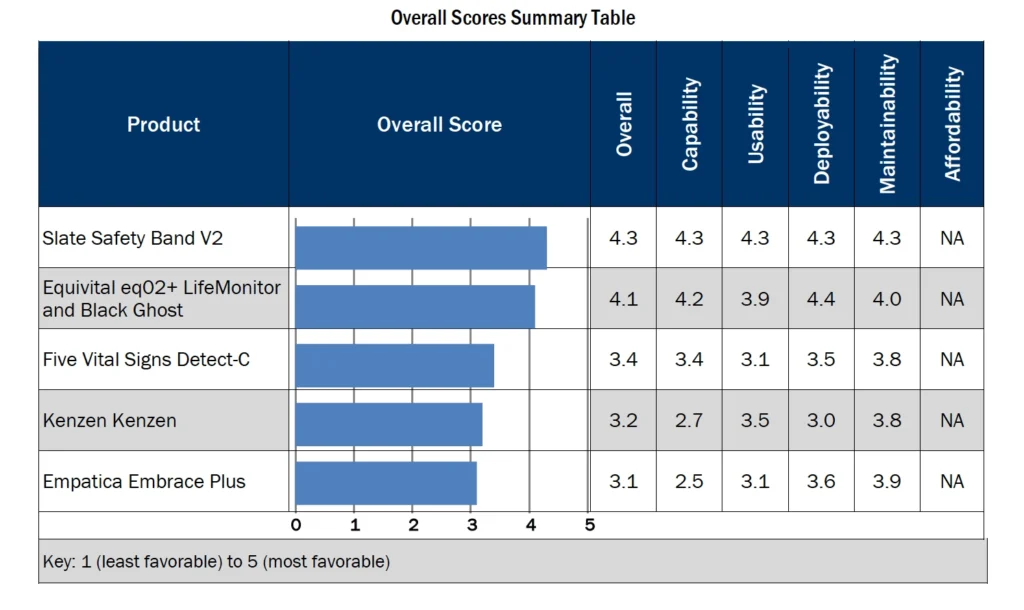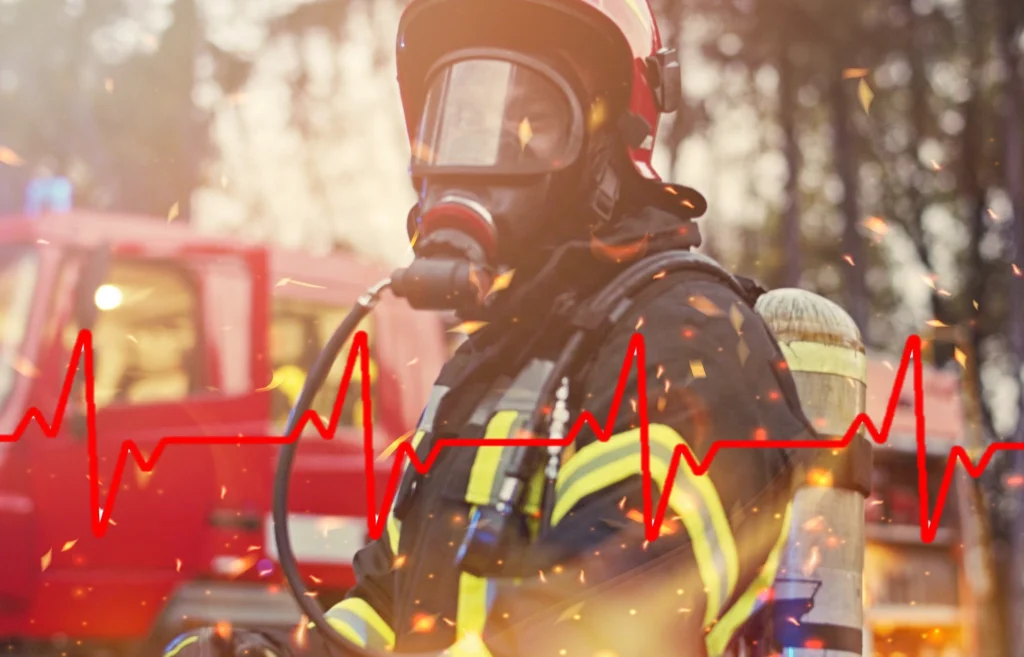A recent assessment conducted by the National Urban Security Technology Laboratory (NUSTL), which sits within the U.S. Department of Homeland Security (DHS) Science and Technology Directorate (S&T), rated the SlateSafety BAND V2 as the number one physiological monitoring system for first responders.
In November of 2022 the NUSTL, Systems Assessment and Validation for Emergency Responders (SAVER) program began a multi-month operational assessment on the top five commercially available physiological monitoring systems. The assessment was conducted by experienced firefighters from a variety of jurisdictions that evaluated the technologies on 5 categories covering 25 predetermined evaluation criteria.
Based on SAVER market research and product availability, the following five physiological monitoring technology vendors and their associated safety wearable products were selected for assessment:
- Empatica, Embrace Plus
- Equivital, eq02+LifeMonitor and Black Ghost
- Five Vital Signs, Detect-C
- Kenzen, Kenzen Device
- SlateSafety, Band V2
At the conclusion of the assessment, the SlateSafety BAND V2 was judged best in class in 24 out of the 25 evaluation criteria.

Purpose, Methodology and Evaluation Criteria
The physiological monitoring systems assessed aimed to redefine the landscape of first responder safety by providing real-time data on vital safety metrics during incident response. These systems play a crucial role in ensuring the well-being of responders, offering a technological edge to optimize incident management.
The evaluation took place at the Orange County Fire Training Center, providing a realistic operational environment with technical support from the Pacific Northwest National Laboratory(PNNL). First responder evaluators actively participated in the assessment, offering real-world insights into the practicality and effectiveness of the physiological monitoring systems.
NUSTL and PNNL employed a comprehensive set of 25 criteria to assess the capability, usability, deployability, and maintainability of the physiological monitoring systems. These criteria, meticulously crafted with input from a SAVER focus group, covered essential aspects vital to the efficiency and reliability of these life-saving technologies.
Assessment Evaluation Categories
- Affordability: Encompassing the overall cost of ownership throughout the product’s lifespan, including purchase price, training expenses, warranty fees, recurring charges, and maintenance costs.
- Capability: Pertaining to the features or functionalities inherent in the product, essential for executing tasks relevant to responders.
- Deployability: Focusing on the preparations required to use the product, encompassing aspects such as transport, setup, training, and any operational or deployment constraints.
- Maintainability: Involving routine maintenance, storage, calibration, and minor repairs conducted by responders, along with details regarding included warranty terms, duration, and coverage.
- Usability: Centering around ergonomics and the overall user-friendliness experienced while executing tasks pertinent to responders.
An Overview of the BAND V2’s Evaluation
The SlateSafety Band V2 ranked the highest in 24 out of 25 evaluation criteria and earned the highest blended score of the assessment with a 4.3. Here’s a comprehensive breakdown:
Capability Assessment (Score: 4.3)
- Health Status Alerting
- Exceeded expectations with real-time alerts to command, utilizing haptic alerts and SOS tap functionality.
- Positive feedback on the prioritization of alerts, although one evaluator cautioned about potential overwhelm.
- Physiological Measures
- Met or exceeded expectations for heart rate, core body temperature, exertion level, calories burned, distance traveled, responder down detection, and GPS location.
- Suggestions for improvement included incorporating respiratory rate, blood oxygen saturation, and ECG data.
- Remote Sensor Platform
- Commended for effective data transmission over cellular networks, Bluetooth, and optional gateways.
- Minimal disruptions reported, and seamless reconnection after a loss of cellular connection.
- Data Privacy
- High satisfaction with privacy standards, with minimal concerns about personally identifiable information.
- Some evaluators raised questions about encryption responsibility and the absence of compliance details with HIPAA or NIST standards.
- Data Sharing
- Exceeded expectations in data sharing capabilities, particularly through API functionality.
- Easy data export to Excel files noted, with emphasis on user-friendly mechanisms.
- Profiles or Baselines
- Strong performance in creating and managing individual profiles, facilitating easy device sharing among staff.
- Streamlined configuration on the dashboard received positive feedback.
- Location Services
- Effective outdoor location tracking through GPS data.
- Varied opinions on the necessity of indoor tracking, with concerns raised about the map interface on the dashboard.
Usability Assessment (Score: 4.3)
- Accuracy
- Generally met or exceeded expectations, with acceptable accuracy compared to reference devices like pulse oximeters and thermometers.
- Battery Life
- Met or exceeded expectations, with acceptable battery life even with GPS enabled.
- Concerns raised about charging time impacting continuous usage between shifts.
- Comfortable Fit
- Favorable feedback on the comfortable and adjustable fit, with a Nomex strap suitable for firefighting applications.
- Mixed opinions on bulkiness; some found it noticeable, while others appreciated the low-profile design.
- Command Interface
- Intuitive interface exceeding expectations, offering various data viewing options and customizable features.
- Negative feedback on historical data retrieval difficulties.
- Ease of Donning and Activation
- Exceeded expectations in ease of use, automatically transmitting data upon wearing without a need for manual activation.
- Positive feedback on simplicity and quick initiation.
- Compatibility with PPE
- Generally met expectations, with praise for low-profile, lightweight design.
- Some mentioned slight bulkiness.
- Wearer Interface
- Exceeded expectations, with strong haptic alerts and positive feedback on the SOS tap feature.
- Some variability in evaluator experiences, with one noting a lack of sensation during specific activities.
Deployability Assessment (Score: 4.3)
- Scalability
- Exceeded or met expectations for scalability, allowing the addition of unlimited wearers to the dashboard.
- Easy user addition and sensor exchange capabilities noted.
- Software Compatibility
- Generally met expectations, with a web-based command interface accessible through internet browsers.
- Mixed opinions on the need for a mobile app.
- Third-party Software Integration
- Exceeded or met expectations, with an API supporting data streaming to other platforms.
- Limited demonstration during assessment raised concerns for some evaluators.
Maintainability Assessment (Score: 4.3)
- Cleaning/Decontamination
- Exceeded or met expectations, with easy cleaning and an IP68 rating suitable for water immersion.
- Appreciation for machine washability.
- Durability
- Exceeded expectations, with high scores attributed to water resistance and perceived robustness.
- Varied opinions on the expected lifetime.
- Battery Type
- Generally met or exceeded expectations, with rechargeable batteries favored.
- Some desire for alternate power supply options.
- Customer Support
- Generally met or exceeded expectations, with some evaluators citing positive experiences with website chat support.
- Noted absence of specific information regarding support hours.
- In-House Maintenance
- Not applicable, as in-house service or calibration is not needed for the Band V2.
Affordability Assessment (Information Only)
- List Price
- Varied opinions on affordability, with some considering it reasonable and others deeming it too costly.
- Suggestions for flat pricing without a subscription component.
- Additional and Recurring Costs
- Mixed opinions on the $15 monthly software subscription cost, with divergent views on its expense.
- Acknowledgment that software is considered the product’s best feature.
- Contract Listing
- Noted absence of information regarding contract options from the vendor.
Summary of Findings and Conclusion
This assessment from the National Urban Security Technology Laboratory’s SAVER program offers a robust and thorough survey of the top personal physiological monitoring solutions available to first responders.
As outlined in the report, the SlateSafety BAND V2’s assessment on capability, usability, deployability, and maintainability position it as a top choice for organizations prioritizing health and safety. This comprehensive evaluation provides valuable insights into the BAND V2, how it compares to similar solutions in the field and offers a roadmap for organizations seeking cutting-edge solutions in first responder technology.
Read the full assessment here.
About SlateSafety
SlateSafety, a pioneering technology startup from Atlanta, GA, is paving the way in the Connected Safety revolution. They aim to deliver robust, trustworthy, and user-friendly safety systems to high-risk industrial settings, prioritizing the worker’s safety. Their innovative product, BAND V2, epitomizes this, offering a wearable Industrial Internet of Things (IIoT) device designed to be worn on the arm. This device provides instantaneous alert notifications and examines historical data trends, enabling safety experts to step in before potential incidents occur and pinpoint operational inefficiencies in work processes. BAND V2 was recently honored by TIME as one of the ‘Best Inventions of 2021‘. In addition, SlateSafety has received more than $2M in funding from organizations such as the National Science Foundation and the United States Air Force to develop its IoT platform. For more information, go to www.slatesafety.com.

